Eugene P. Trani and David L. Wilson, 1977
When I first went looking for a book about Harding, I was pleased to discover a book from 2014 called A Companion to Warren G. Harding, Calvin Coolidge, and Herbert Hoover. Great!, I thought, I can just read this and knock out all three of them at once. But when I finally got hold of a copy, it turned out to be a collection of annotated bibliographies, both on the listed presidents and on important issues of the 1920s. Ah well, I thought, at least it'll point me toward the best book on each of these guys. So I dug into the chapter on Harding biographies, and it soon became clear that nearly all of them were primarily gossip. Here's a book contending that Harding died in office because his wife poisoned him! Here's a book from his teenage mistress, now grown up and claiming that Harding was the father of her child! And of course these days Harding is probably best known for the recently released love letters he wrote to a different mistress of his, in which, to John Oliver's glee, he referred to his penis as "Jerry". I suppose this focus on gossip isn't too surprising; Harding was in office for less than two and a half years, and didn't do much, so what else is there to write about? Even the less prurient writeups on Harding, like those that appear in textbooks, tend to focus on the leadup to and aftermath of his presidency rather than the presidency itself. I read a book about the Harding presidency, and I can see why they do — his presidency was a whole lot of nothing. But that leadup and aftermath are pretty interesting, so let's look at those.
Warren Harding was a small-town newspaperman who leveraged his local big-fish status and steadfast support of Republican officeholders into a successful run for the Ohio state senate, where he quickly became very popular. His chief asset was that, in a profession full of assholes, he was a congenial guy who was always up to play a round of golf or a few hands of poker and trade favors — this vote in exchange for a job for a family member, that vote in exchange for free train tickets. When the Republican Party divided into competing factions during the progressive era, Harding supported William Howard Taft and the conservatives over Theodore Roosevelt and the progressives. And when this Republican split got Democrat Woodrow Wilson elected, which direction the Republican Party headed was essentially up to Wilson: when Wilson governed as a progressive, the Republicans, as the opposition party, reflexively became more conservative. With his wing of the party in the ascendant, Harding became the Republican nominee for a U.S. Senate seat in 1914, which he won handily. (Nativist smears against his Catholic opponent, which Harding did nothing to stop, didn't hurt.) In Washington, Harding quickly gained a reputation very similar to the one he'd acquired in Columbus, as a swell guy to smoke cigars and drink whiskey with, but not much more than that. In a normal year, it was unlikely that he would have run for president, let alone become the Republican nominee. But 1919 saw a breakdown of order in the United States — strikes, bombings, riots, lynchings — and with Wilson incapacitated by a stroke, the nation seemed dangerously adrift. 1920 looked to be a golden opportunity for the Republicans to retake the White House, and pretty much everybody ran. At the convention, the first ballot was split fifteen ways, with Harding in sixth place. But a lot of the support for the candidates ahead of him, all of whom represented the party's progressive wing in some way, came from conservatives hoping to preserve a deadlock and keep any one of them from actually winning. When that deadlock finally started to break down, the conservatives needed to pick a candidate from their wing of the party — realistically, either Harding or Calvin Coolidge — or risk watching a progressive get the nomination. The ninth ballot saw an enormous shift to Harding, with Coolidge selected (against Harding's wishes) as his running mate.
America had become a dramatically different place as the twentieth century had unfolded. Corporations could no longer monopolize industries quite so easily thanks to antitrust legislation. A progressive income tax funded the government according to the principle that the dollars procured for public uses should be those doing the least good in private hands. Control over monetary policy was transferred from Wall Street bankers to appointees of democratically elected officials. Those elections became more truly democratic with the extension of the vote to women. Women also looked forward to being beaten by drunken husbands less often due to the prohibition of alcohol. Food and medicine were now inspected for safety. Natural wonders were protected from commercial development. But while the U.S. was making all of these advances, World War I was erupting in Europe. Among the results: Over 100,000 American troops were killed. Factory jobs supporting the war effort opened up, prompting a wave of black migration from the South into northern cities and freaking out racists. The Bolsheviks grabbed control of Russia, touching off a nationwide panic in the U.S. that immigrants and radicals were about to launch a communist revolution here as well. And Wilson took it upon himself to rewrite the rules of international relations, then returned home to insist that the U.S. enter a League of Nations that would permanently entangle it with the scary world across the ocean. This string of events gave the Republicans an opening. If they could convince the public that all of the above was of a piece — if they could associate the achievements of the progressive movement with Reds, race riots, and trench warfare — they could run on conservatism itself. This is what Harding did. Shortly before the convention, he had delivered the speech that sounded the theme of his campaign, the most famous passage of which is this:
America's present need is not heroics, but healing; not nostrums, but normalcy; not revolution, but restoration; not agitation, but adjustment; not surgery, but serenity; not the dramatic, but the dispassionate; not experiment, but equipoise; not submergence in internationality, but sustainment in triumphant nationality.
Warren Harding was no policy wonk, and this is no Clintonian laundry list of legislative proposals. This, like the rest of the speech, is close to pure abstraction. It's a broadside against action ("heroics", "the dramatic"), against change ("revolution", "agitation", "experiment"), and more specifically, against attempts to solve problems ("nostrums", "surgery"). Harding's call for America to return to "normalcy" was very well received — he won the 1920 election in a 26-point landslide — and it is commonplace to say that he had captured the mood of the country as the progressive era gave way to the 1920s. But I think Harding's rhetorical impact goes beyond that. The Republican Party had formed in the 1850s for a single purpose: to fight against the extension of slavery beyond its designated boundaries. The end of slavery left the Republicans without much of a platform. They were the northern party… the more socially progressive party… the party of the rich. But Harding made very clear what the Republican Party now was, and would be for generations after him: it was the conservative party, the reactionary party, the backward-looking party. In the 1996 presidential campaign, when Democratic candidate Bill Clinton repeated ad nauseam that he wanted to "build a bridge to the 21st century" and Republican candidate Bob Dole replied that he wanted to return America to what it had been in his youth, to "be the bridge to an America that only the unknowing call myth", to "be the bridge to a time of tranquility, faith, and confidence in action", we saw the lasting legacy of Warren Harding on the American political landscape.
Of course, Dole didn't get elected, and Harding did. So how did Harding go about building his bridge to the 19th century? Mainly by picking a cabinet and getting out of the way. For instance, he chose as his treasury secretary the third-richest man in America, Andrew Mellon, who promptly gave Congress detailed instructions on precisely how he wanted to slash taxes on the rich. Despite the fact that Republicans dominated Congress, swept in by the wave of 1920, there was some pushback against Mellon's proposals, as representatives from agricultural states formed a "farm bloc" that didn't look kindly upon the idea of putting the nation back in the hands of Eastern bankers. With Mellon in one ear and the farm bloc in the other, Harding confessed that he had no idea what to do: "I can't make a damn thing out of this tax problem," he told his secretary. "I listen to one side, and they seem right, and then — God! — I talk to the other side, and they seem just as right, and here I am where I started. I know that somewhere there is a book that will give me the truth, but, hell, I couldn't read the book." Eventually he sided with Mellon, and signed a bill into law that cut the top marginal tax rate in stages from 73% in 1921 to 25% in 1925. Meanwhile, foreign policy became a battleground between secretary of state Charles Evans Hughes and secretary of commerce Herbert Hoover, who maintained that any international agreements that had anything whatsoever to do with trade fell within his purview. Harding himself wound up doing things like answering the White House mail. Asked whether that sort of thing wasn't beneath the president, Harding replied, "I suppose so, but I am not fit for this office and should never have been here." He griped that he couldn't go out anymore, and was frequently heard to mutter, "God, what a job!" and "This is hell!"
One of the things that made the presidency so hellish for Harding was that he had surrounded himself with crooks. Hughes, Hoover, and Mellon had already been big names in the Republican Party when they were selected for cabinet posts, but Harding filled other important positions with his poker buddies. Among these were his campaign manager, Harry Daugherty, whom Harding appointed as attorney general, and under whom the Department of Justice became notorious for accepting payoffs from bootleggers; Charles Forbes, named director of the Veterans' Bureau, who embezzled millions of dollars while rejecting tens of thousands of disability claims from wounded veterans on specious grounds; and, most famously, naval secretary Edwin Denby and interior secretary Albert Fall, who colluded to illegally lease government oilfields to private companies in exchange for six-figure bribes. (This was the Teapot Dome scandal, which made Fall the first cabinet official to go to prison for corruption.) Harding died of multiple health problems before these scandals came to light, and his advocacy of "normalcy" had made him popular enough that he received a hero's funeral. But his reputation crashed almost immediately thereafter, as the scandals made the papers and his drinking and infidelity became more widely known. Ever since, those few books about Harding that haven't focused on gossip have taken the same starting point: "Warren Harding is routinely ranked as the worst president in American history. Was he?" Trani and Wilson, writing in the aftermath of Watergate, make an interesting point. History textbooks take pains to specify that, for all the criminal acts perpetrated by members of his administration, Harding himself was never personally involved with any of their schemes. But he did have some idea of what was going on, fuming that "I can take care of my enemies all right, but my damn friends, my goddamn friends […] they're the ones who keep me walking the floor nights!" He had one of Daugherty's crooked aides dropped from his entourage on a cross-country tour but not otherwise disciplined, allowed Forbes to resign and flee to Europe rather than face charges in the U.S., and asked Hoover for advice about what a president should do if he "knew of a great scandal" in the administration. When Hoover said he would expose it "and at least get credit for integrity", Harding "abruptly dried up" and cut Hoover out of the loop. Harding, Trani and Wilson contend, showed every sign of being inclined toward a Nixonian coverup of his administration's scandals, and only the intervention of death saved what little positive reputation he still possesses.
Perhaps the best known biography of Warren Harding is The Shadow of Blooming Grove, published in 1968. In it, author Francis Russell contends that Harding's devotion to "normalcy" and his need to get along with and be accepted by everyone stemmed from his insecurity over rumors that he was black.
On its face, "rumors that he was black" is a ridiculous phrase. "Hey, it looks like you're wearing an orange shirt… but I've heard rumors that it's actually green!" It seems like the sort of thing we should be able to resolve empirically. Like, here are some pictures of Warren Harding:
 |  | 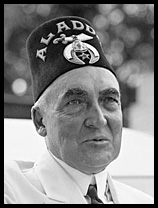 |
Let's throw that middle one into Photoshop and break out the eyedropper tool. Looks like Harding's somewhere in the neighborhood of an #fa9. Black, of course, is #000. Rumors: disproven! Except, of course, that "black" in this context doesn't actually mean black. This confused the hell out of me when I was a kid. I think I first encountered this second use of the word when I was four or five years old, watching Tic-Tac-Dough at my adoptive grandparents' house, and one of them referred to one of the contestants as "black". I objected that, no, he was very clearly brown, and it was explained to me that people with that skin tone were called black. I tried to wrap my head around this. Okay, so… my father is black, then? Because his skin tone was the same as that of the guy on TV. And I was told, no, only some people with that shade of brown skin were called black, and my dad wasn't one of them. "Black" people had brown skin and certain facial features. Now, at the time, my dad looked enough like Johnny Mathis that when I saw Johnny Mathis albums in record stores I did a double take. So, I asked, if my dad isn't black, because of his facial features, then Johnny Mathis isn't black either, right? No, I was told, Johnny Mathis definitely is. None of it made a lick of sense.
Things got even more confusing when I learned that not only were there people with dark skin who weren't "black", but there were people with light skin who were. I think the first light-skinned person I was bewildered to hear described as black was Lena Horne. Here are some pictures of her:
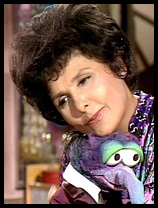 | 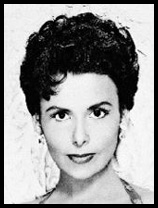 |  |
The picture on the left is from her appearance on The Muppet Show, which is where I first saw her; I recognized her name from the album The Stars Come Out on Sesame Street, and here was the face to go with it. Light skin, European features, straight hair. So when a few years later I heard adults calling her "black", I was mystified. What on earth were they seeing in her that I couldn't see? Take the second two pictures there. The middle one is of Lena Horne, who is considered "black". The one on the right is of Elizabeth Taylor, who is considered "white". You're telling me that there are people who see a great disparity between these two pictures? They're virtually identical! It's like a few years ago when kids would put up pictures of two haircuts and explain that that one's emo and that one is scene, and no one born before about 1995 could tell the difference.
I, of course, am somewhat older than that — old enough to have followed the presidential race in 1984, when Walter Mondale battled Gary Hart for the Democratic nomination, with Jesse Jackson running a strong third. My adoptive grandmother dismissed Jackson's chances: "America isn't ready for a colored president," she explained. But just seven years later, the conventional wisdom held that our first black president was right around the corner, for with his 91% approval rating, George Bush was certain to win reelection in 1992, and with vice president Dan Quayle still a national joke, the Republican nomination in 1996 — and then the presidency, because Democrats never win — was sure to go to Colin Powell. And I was shocked — not because a black person was favored to take the White House, but because I'd never had the faintest inkling that Colin Powell was black. I mean, I did know what he looked like — he looks like this:
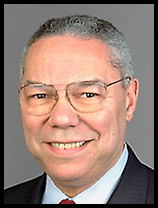 | 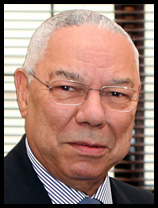 |
Colin Powell was then the Chairman of the Joint Chiefs of Staff, and told Parade magazine that he'd been able to avoid hitting a glass ceiling in the Army because he was "never a very threatening kind of black man" and was considered "a good Negro to have around." Of course, by 1991, the word "Negro" had largely vanished from public discourse, replaced by "African-American". Powell does have some African ancestry. His parents were immigrants from Jamaica, and Jamaica had been a British sugar colony, 95% of whose population in 1800 consisted of black slaves. But Powell also traces his ancestry back to Scotland, and has a Scottish coat of arms — and a skin tone much more common in Scotland than in West Africa. So why is he considered black?
The short answer is that American society has long operated according to the "one-drop rule", which holds that anyone with any African ancestry whatsoever is black. For instance, consider these three men:
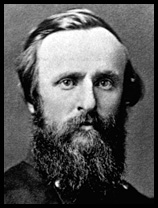 | 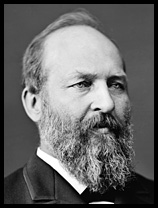 |  |
They all look pretty similar! Same skin tone, same hair texture, same beard texture — even the same gray streaks in those beards. The first one is Rutherford Hayes, 19th president of the United States. He is considered white. The second is James Garfield, 20th president of the United States. He is considered white. The third is Pinckney Pinchback, 24th governor of Louisiana. He is considered the first black governor in American history, and the only African-American to govern a state before 1990, when Douglas Wilder (who looks like this) took office in Virginia. Pinchback's ancestry is known to have been at least 75% European, but while the U.S. had a complex nomenclature for fractional African ancestry, it was academic. Pinchback was termed a "quadroon"; that made him black. Harding was suspected of being an "octoroon"; that would have made him black. And Harding's daughter by his teenage mistress would have been considered a possible "mustefino", which, again, would have made her only 94% white, and therefore black.
That's the short answer. The long answer is longer. First of all, everyone in the world is of African ancestry if you go back far enough, but let's set that aside as a technicality. Consider these fellows here:
 | 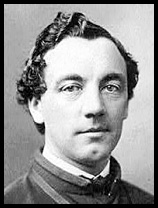 |
On the left is Michael Healy. Born a slave, he became the first African-American to command a U.S. government ship, and served as the sole representative of U.S. law in the vast territory of Alaska from 1882 to 1903. On the right is his brother, Patrick Healy. Also born a slave, he became the first African-American to earn a Ph.D., and the first to be ordained a Jesuit priest. He then became a philosophy professor at Georgetown University, and rose to become that institution's president, the first African-American to hold such a position at a white university. And Georgetown was a white university — it didn't accept its first black student until 1947 or its first black undergraduate until 1950, 68 years after Healy stepped down. So how did he land this job, and how did Michael land his? Easy: they told everyone they were of full-blooded Irish ancestry, and no one was the wiser. Michael Healy's own son had had no idea that he had any African ancestry. Not until half a century after their deaths was their family history made public and their pioneer status retroactively acknowledged.
And this sort of thing happened all the time. Take the case of Susanna Eppes, a slave of (so far as is known) 100% African ancestry. She was impregnated by an English sea captain named John Hemings, and gave birth to a daughter, Betty; though half white, as the child of a slave, Betty Hemings was also a slave. Her owner was a man named John Wayles, six of whose children Betty bore; though three-quarters white, as the children of a slave, they were also slaves. John Wayles had been married three times, and had five daughters by his wives, the eldest of whom, Martha Wayles, was designated to inherit Betty and her children (six of whom were Martha's half-siblings) upon John's death. John Wayles died in 1773, by which point Martha had already been married, widowed, and married again; her new husband was named Thomas Jefferson, and he eventually became the third president of the United States. Martha died long before that, and her half-siblings were legally considered Jefferson's property. The youngest of them was named Sally Hemings. She was said to look just like Martha, only 25 years younger, and Jefferson had six children with her, four of whom lived to adulthood. Though seven-eighths white, as the children of a slave, they were also slaves… except the two eldest escaped, changed their names, and joined white society. The youngest was freed when Jefferson died, and did the same. All of their descendants identified as "white", and so it came to pass that an awful lot of white people could trace their ancestry back to Susanna Eppes and therefore to Africa.
Earlier this month, a white supremacist murdered nine people in an African-American church in Charleston, South Carolina, telling the survivors that he'd done it because "you rape our women". But look at Sally Hemings's story: her half-white mother was impregnated by the man who owned her, and her mother was half white because her mother had been impregnated by a white man. Look at the Healy brothers' story: their half-white mother was impregnated by the man who owned her, and their mother was half white because her mother had been impregnated by a white man. Look at Pinckney Pinchback's story: his half-white mother was impregnated by the man who owned her, and his mother was half white because her mother had been impregnated by a white man. These people, and countless others like them, were the offspring either of rape or of relationships across such a steep power differential that distinguishing them from rape is somewhere between difficult and impossible. (Even if we didn't have these stories, we could infer them from empirical evidence: over 30% of African-American men have Y chromosomes of European origin while only 6% have mitochondrial DNA that traces back to Europe.) Genetic markers suggest that African-Americans have, on average, upwards of 20% European ancestry. But it has long been an open secret that the transfer went both ways. There was a reason that there arose terms for people with ever smaller fractions of African ancestry: lighter-skinned female slaves tended to be targeted by their owners, and as we've seen, over generations the result was people who could and did pass for white and who passed African ancestry to their "white" descendants. You may recall that a couple of years ago a white supremacist named Craig Cobb made the news for attempting to turn a small North Dakota town into an avowedly white separatist community, only to become himself the target of white supremacist violence when a DNA test indicated that his ancestry was 14% Sub-Saharan African. This sort of thing made formal adoption of the one-drop rule a treacherous proposition for the Southern elite. When South Carolina tried to enshrine it in its state constitution in 1895, former congressman George Tillman warned, "It is a scientific fact that there is not one full-blooded Caucasian on the floor of this convention," pointing out that even before people of European ancestry and people of African ancestry had spent centuries interbreeding in the New World, Europe had repeatedly been invaded by people from different parts of Asia, and that even those who could somehow be certain that none of their ancestors was a Michael Healy or Eston Hemings had undoubtedly "received a certain infusion of darker blood" from "the Arab, Mongolian, Indian, and other colored races". And the white population continued to receive fresh infusions of African genetic markers long after the end of slavery — in 1947, the president of the NAACP, Walter White (who looked like this), estimated that 12,000 "white-skinned Negroes" successfully "disappeared" into white society each year.
Speaking of the NAACP, earlier this month the Internet erupted when the president of the Spokane NAACP, Rachel Dolezal, was outed by her parents as "white" (though purportedly with "faint traces" of indigenous ancestry). What made such an obscure story dominate online conversation for several days was the way conservatives gleefully pounced on it as a counter to the media blitz that accompanied the announcement that the 1970s celebrity athlete heretofore known as Bruce Jenner now identified as a woman and preferred to be called Caitlyn. The Tumblr mantra that a person's sexual identity is entirely a matter of that person's choice suddenly seemed to have been universally accepted in mainstream discourse, to the point that you had Bible-thumping Republican presidential candidates shrugging that, sure, if someone with a penis wants to be called "she", then of course you have to respect that. Now the #tcot brigade saw an opportunity to turn this rhetoric around. If a man can maintain that, biology to the contrary, "My true self is female!", then surely a white woman can maintain that, biology to the contrary, "My true self is black!", right? If we have to accept Jenner as "transgender", then surely we must also accept Dolezal as "transracial"! Then they put on their trollfaces and waited to see what kind of sophistry the lefties would resort to in trying to rescue Jenner while condeming Dolezal.
And the argumentation I have seen against the existence of transraciality has in fact been quite poor. So far, the arguments I've seen have fallen into four categories:
1) Being transgender is a thing, but being transracial isn't. It just isn't!
Yeah, argument by vehement assertion "isn't a good look," as the kids say. But it's not uncommon. I've run across a number of Tumblr blogs that take the form of a person or small group of people who feel subaltern and/or oppressed on one or more axes making up for their feelings of powerlessness in the outside world by handing down imperial edicts in the virtual space they control. I recall one in which the maintainers demanded that English speakers recognize "singular they", and derivative constructions such as "themself", as legitimate pronouns for people who don't feel like they fit into the "gender binary". One reader wrote in to say that, while she identified as a cis female, she strongly supported the idea of de-gendering the English language, and wanted to start requesting that people use they/them pronouns to refer to her… but she wanted to check in first and ask whether that would be offensive. To which the maintainers replied that they thanked her very much for asking, and that yes, it was grievously offensive. "Singular they" was for alternatively gendered people only! Anyone else using it was appropriating the experience of an oppressed group! So it is decreed!
Not that the mainstream consensus about which phrasings are offensive and which phrasings are mandatory is any less arbitrary. For instance, as Bloom County pointed out way way back in the 1980s, what could possibly be more absurd than to say, with a straight face, that "colored people" is a racist relic but that "people of color" is somehow enlightened and progressive? Because, uh, it's really not. I actually do find it offensive — hearing someone say "people of color" makes me wince the same way I wince when I hear people calling each other "nigga". One reason is that it implies that racial identity is a function of the wavelengths of light that reflect off a person's skin, which, as I've already discussed ad nauseam, is untrue. And I haven't even mentioned the fact that, despite the assertion in some articles about the Dolezal controversy that skin color is hereditary, you can't actually predict the skin color of a child by looking at the parents. My family is a case in point. My father is of mixed South Asian and Southwest Asian ancestry, though he grew up in Southeast Asia and, when asked, identifies as being from Malaysia, though he has no ethnic Malay ancestry of which I'm aware. He has brown skin; if you want to know the precise shade, go find a picture of Johnny Mathis. According to my mother's adoption papers, she is of mixed Northern European ancestry, though there are a lot of question marks. She has fair skin. Now, my brothers and I all have the exact same ancestry. Presumably that makes us members of the same "race". But my brother Rabie has dark skin like our dad's — he looks a bit like Danny Pudi from Community, who is also of South Asian and Northern European ancestry — while my brother Raihan, who died last year at age 36, had fair skin like our mom's. And mine is a caramel color that I guess is what you'd get by averaging the two — it was closer to bronze when I was a kid, but a lifetime spent indoors has lightened it somewhat. So, does that make Rabie "of more color" than I am? Was Raihan not welcome to join us in the "of color" club? And not only can the exact same ancestry be physically expressed in all sorts of different ways, but differing ancestries can converge. Here's another set of pictures:
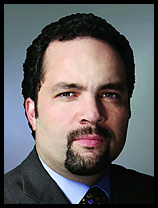 | 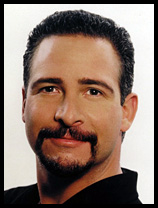 |  |
On the left is Ben Jealous, who from 2008 to 2013 was national head of the NAACP. As "NAACP" stands for "National Association for the Advancement of Colored People", you can probably guess that he is considered a "person of color". In the middle is a sports radio guy named Jim Rome, who looks a lot like Jealous (and not just because of their tonsorial choices), and may even have somewhat darker skin. But he's considered "white". On the right is Death of the Endless, who is an example of what an actually white person would look like, but who is fictional, because while the phrase "people of color" implies that there are "people of no color" in the world, this is both false and regressive. Pink is a color. Light beige is a color. Everyone has a color, just like everyone speaks with an accent. To argue otherwise is to accept the frame that some people are "ethnics" but others are "normal", unmarked defaults. That is a frame that we should be working to dismantle, not propping up. But again, what most offends me about the phrase "people of color" is just the sheer facepalminess of the idea that it's any different from "colored people". Seriously? It's as if the owner of the Washington Redskins responded to complaints that the name of the team is an ethnic slur by changing it to "Washington Skins of Red"… and found that it worked, that the protesters were delighted with the change!
2) You can't choose your racial identity, because racial identity is something that is thrust upon you. You're black if the cops think you're black. And people they deem black don't get to say, "Pardon me, officer, but I actually consider myself white, so could you please treat me with the corresponding amount of deference rather than murdering me? Thanks!" It's dishonest to claim a black identity unless you've spent a lifetime suffering the disadvantages that come with being branded with that identity.
It's true that not everybody deemed "black" can claim a white identity that will convince the power structure (though, as noted, hundreds of thousands if not millions of such people have done exactly that). But I don't see how this argument operates any differently whether it's applied to transracial identity or transgender identity. FTM people may be able take testosterone supplements, apply some Rogaine, and grow goatees, but that doesn't actually give them automatic access to the old boys' network. And while, just as some "black" people can pass for "white", some transgender people can present themselves as members of their chosen sex without anyone suspecting that they're trans… many others can't. When they are treated as members of the sex of their choice rather than of the sex they were assigned at birth, it's not because they "look cis", but because society, or at least certain segments of it, has come to the understanding that that's the decent way to treat trans people. Why wouldn't those same segments of society extend that sense of what's decent from gender to race, no matter what the cops might have to say about it? As for situations like the Dolezal case, in which a person identifies as a member of a subaltern group to which society has not assigned her… how is that different from the experience of MTF people? Wouldn't the parallel argument be that when they were growing up they didn't experience the threats and discrimination that go along with being recognized by society as a girl, and therefore have no right to claim a female identity? I know that there are feminists who do make this argument, but they tend to be at the top of the "I will block you!!" lists of the very same people who claim that transraciality isn't a thing. I just don't see the difference.
3) Transgender expression and "transracial" expression have different cultural contexts. While drag has historically been about exploring queer identity rather than about mocking women, blackface has a much uglier history and has made a white person attempting to present herself as black forever off-limits in a way that cross-dressing isn't.
It wasn't until I took a bunch of classes about 19th-century American culture that I learned exactly how big a phenomenon blackface really was. It started around 1830 and by the late 1840s was in many respects America's dominant entertainment form. It began as a pure expression of racial contempt — the entire performance was about nothing other than mocking black people — and obviously racial contempt never ceased to be an ingredient in blackface. But the form achieved such success that, as time went on, putting on blackface actually became de rigueur for almost any performance intended for a popular audience. Like, even if all you wanted to do was sing some of the popular songs of the day, you pretty much had to smear your face with burnt cork — that was how you advertised that your show was for everybody and not just a handful of snobs. The massive popularity of blackface seems bizarre now, but at the same time, it makes a lot of sense: as it grew clearer that slavery was not going to naturally die out as America's founders had expected, whites who were complicit in the institution — not just slaveowners, not just Southerners, but anyone who wasn't fighting to end slavery — needed to immerse themselves in the message that black people were inferior and deserving of their subjugation, or go mad under the weight of responsibility for such an evil.
I can't really speak to how that compares to the role drag played in the emergence of communities centered on alternative sexualities. For someone who spent seven years in a relationship with someone who did her master's thesis on cross-dressing, I know appallingly little about it. Queer theory is not my field. But I can say that cross-dressing in mainstream comedy has problematic underpinnings. The point is not to directly demean women the way that the point of blackface was to directly black people; the point is to laugh at men for looking like women, which indirectly demeans women. As Julie says in The Cement Garden, "Girls can wear jeans and cut their hair short and wear shirts and boots, because it's okay to be a boy. But for a boy to look like a girl is degrading, because you think that being a girl is degrading." It seems worth noting that drag was a big part of blackface — another humiliation to heap onto the pile. So I'm not so sure these are as different as all that.
I've actually read a number of articles critical of Dolezal that explicitly forgive her on the blackface charge, saying that intent matters, and that Dolezal was clearly not out to mock black people by presenting herself the way she did. But other critics have chided her specifically for frizzling her hair, comedians have lampooned her by putting on bad wigs, and some people have made it clear that, no matter what the intent, anything hinting at blackface crosses a red line for them. Which I can understand. I have heard lots of people defending their use of the word "nigga" (and its unadulterated cousin), saying that it's the intent that counts, and that if they mean it as a term of friendship, then its history is irrelevant; I see where they're coming from, but for me that is still a capital-N Nope. But it also seems to me that it's one thing to say that expressing a particular kind of transracial identity is unacceptable in America for historical reasons, and quite another to say that transracial identity doesn't even exist. I don't think objection #3 supports the latter.
4) Transgender is a thing and "transracial" isn't because race isn't real but sex is. You can feel like a woman trapped in a man's body, because "feeling female" is a biological phenomenon, but you can't feel like a black woman trapped in a white woman's body, because "blackness" is a social construct and not something you can truly feel.
I do hope that if this core dump of an article has managed to make some points, one of them is that race is indeed a social construct. Picture time:
 |  |
On the left, representing your world champion Golden State Warriors, is NBA MVP Stephen Curry. In the U.S., he's considered "black", thanks to the one-drop rule. In apartheid South Africa, he would have been considered "Coloured", a distinct category from "Black" in the racial classification system of that time and place. And in Brazil he'd be white — to the extent that the one-drop rule is applied in Brazil, it works the other way, especially for people with money. Now look at the picture on the right. To Benjamin Franklin, that's a black girl. She's Leonor de Borbón y Ortiz, heir presumptive to the Spanish throne, and as Franklin wrote, "the Spaniards, Italians, French, Russians and Swedes, are generally of what we call a swarthy Complexion; as are the Germans also, the Saxons only excepted, who with the English, make the principal Body of White People on the Face of the Earth." By the 19th century, the French, Russians, Swedes, and Germans were generally accepted in the U.S. as white; the Spanish and Italians took a little longer, as did the Irish. Whether people of Latin American, Southwest Asian, or North African extraction count as white are questions about which there is no current consensus. In summary, the varying amount of melanin in the skins of humans is a biological fact, but the way we group and categorize those humans on that basis is arbitrary, and different societies do it in very different ways. Hence, social construct.
But my understanding is that the notion of transgender identity has the same underpinnings. The difference between the sexes initially seems pretty clear. The preschooler version is "boys have penises and girls have vaginas"; the high school biology class version is "females are XX and males are XY". But eventually it comes out that things aren't always that simple: chromosomal/genetic sex doesn't always match gonadal/hormonal sex, which doesn't always match apparent/phenotypic sex — there are all sorts of ways that prenatal development can differ from its usual course and result in an intersex body that blurs the distinction between male and female. This by itself is not the sort of argument I find particularly compelling; the existence of twilight doesn't prevent "day" and "night" from being useful concepts. But then there's the fact that none of the above necessarily matches psychological sex: it's possible to have a body that falls squarely into one of the two main categories, but that feels like it's the wrong category. Sometimes people who have that experience get reassignment surgery to more closely approximate the type of body that fits their self-image, and for a long time they were called "transsexuals". But that's one of those words that got added to the Offensive list seemingly overnight, replaced by "transgender" — the idea being that whether someone is a "he" or a "she" depends not on anatomy but on self-presentation. And that's where objection #4 runs into trouble, because gender is every bit as much a social construct as race.
Conventional wisdom has it that "gender is a social construct" is something that everyone believes in college and then stops believing after having kids. "I did everything I could to keep my daughter from becoming a stereotype, but from the time she was two years old she wouldn't wear anything that wasn't pink! It must be genetic!" Except in Warren Harding's day, pink was considered the color for boys (as it was "more decided and stronger") and blue was the color for girls (as it was "more delicate and dainty"). Children do indeed get the message extremely early that their primary identity is "girl" or "boy" and attempt to perform that identity, but what constitutes "being a girl" or "being a boy" is pretty arbitrary. Girls wear skirts? So did soldiers in Balkan countries right up to the 20th century… and perhaps you've seen this picture of Franklin Roosevelt in the typical dress of boys at the time. Or to pick an example from a few centuries earlier — I was interested to learn that one of the many reasons English colonists in North America so frequently found themselves in conflict with the indigenous inhabitants of the regions they settled was that the colonists survived by farming. To those indigenous societies, agriculture was women's work, and so the indigenous leaders tended to hold English men in too much contempt to be able to have productive exchanges with them. American toddlers tend to be pretty dogmatic about gender roles, but I suspect that if you were to quiz some of them, they would be less certain that farming is for girls than the Algonquians.
But so what? The collection of traits we call "femininity" may have no inherent connection to femaleness, and those traits may have little or no connection to each other, but that doesn't keep anyone from identifying from some or all of them. I'm reminded of a news story that my grad school colleague Deep Singh was interviewed about: a mixed-race girl had been booted out of class for wearing a nose ring in violation of the school dress code, and her suspension had been upheld because wearing the ring was a cultural rather than a religious practice. Deep quite rightly questioned that double standard — why is religious expression protected but not cultural expression, when religion and culture are both just systems of beliefs and practices? So, yes, race is a system of identity, arbitrarily moored to the biological facts of skin tone and facial features, that has resulted from historical processes. But gender is also a system of identity, arbitrarily moored to the biological facts of reproductive anatomy, that has resulted from historical processes. So if we're talking about transgender identity rather than transsexual identity, then it seems to me that transracial identity is a perfectly good parallel.
A reader pointed me to an article with a fifth objection:
5) It is offensive to compare Rachel Dolezal to transgender people, because it is bigotry to suggest that transgender people are trying to "deceive" people about their true sex, while Dolezal is just a con artist who actually was trying to deceive people about her true race, not genuinely expressing her sense of self.
First of all, says who? What superpowers did these pundits acquire that allow them to look into people's souls and say with such supreme assurance that this person over here is experiencing genuine body dysphoria and that person over there is just a charlatan? One of the most irksome things about contemporary discourse is this notion that it is a moral outrage to cast judgment upon people, and to fail to take them at their word when they talk about their own feelings… except for the people I feel like casting judgment upon, and whose statements about their own feelings I feel like discounting.
Secondly, even if Dolezal is a charlatan, so what? That doesn't eliminate the possibility that someone might genuinely identify as transracial. That's like saying that because a bunch of people have pretended to have cancer, nobody really has cancer. There's a long history of people who did in fact disguise their sex — i.e., they didn't present themselves in a different way in order to express their inner selves, but in order to achieve some goal, like going to war or getting a book published — and their "deceit" doesn't disprove the existence of transgender identity. Again, I could hardly care less about the erstwhile head of the Spokane NAACP. The possibility that anyone could ever hold a transracial identity does not hinge on one data point.
Anyway, this is an addendum, so back to the original article.
Last week the Supreme Court ruled that same-sex couples had the same right to marry as opposite-sex couples. From the right came a chorus of the usual complaints, one of which is, "If marriage isn't limited to one man and one woman, then why not let three people get married?" And while the question is rhetorical, my response is that, yes, that's a good point! Some people do indeed find that a threesome is what works best for them, and the rights we extend to couples absolutely should be extended to larger groups! Similarly, the term "transracial" may have trended on Twitter as a handy liberal-bashing meme. So what? That doesn't make it illegitimate.
And that is what I have to say about the presidency of Warren G. Harding.



